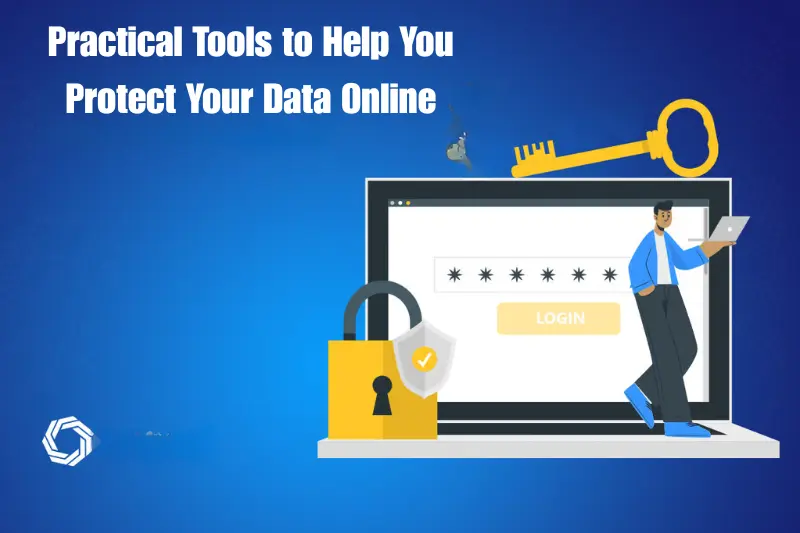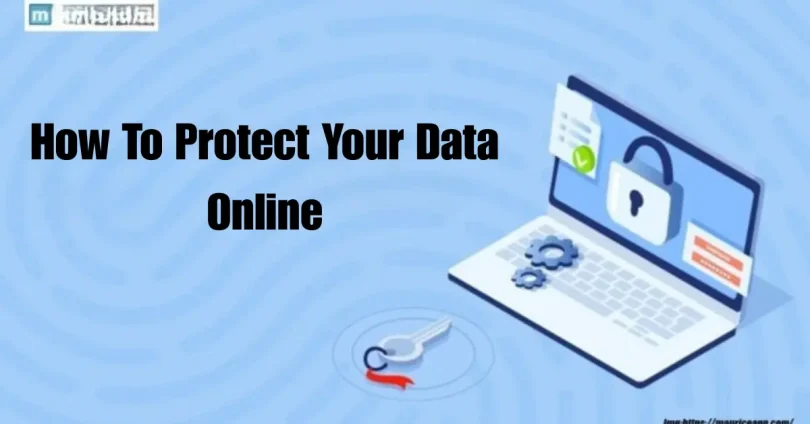In today’s digital world, data is everywhere. Every app you download, every website you visit, every photo you upload—it all creates a digital footprint. And here’s the real kicker: you’re sharing personal data every single day, often without even realizing it.
Let’s take a second and think about it. You probably have:
- Dozens of photos on social media,
- Banking apps on your phone,
- Personal chats and work emails,
- Documents uploaded to cloud storage,
- Shopping accounts with saved payment info.
That’s a LOT of sensitive information floating around. Now ask yourself: Is all of this secure?
If you’re unsure, don’t worry. This article will guide you step-by-step on how to protect your data online. Whether you’re a casual internet user or someone managing a business, these tips will help you stay one step ahead of cyber threats.
Why Online Data Protection Matters More Than Ever

Let’s be real—data breaches are becoming common news. Big companies, small apps, even government portals have been hacked in recent years. And it’s not just about your passwords being leaked—it’s your:
- Identity (name, phone number, address),
- Banking info (credit cards, PayPal, etc.),
- Personal memories (photos, messages),
- Work files (documents, reports).
Once your data gets into the wrong hands, it can be sold on the dark web, used for scams, or worse—used to impersonate you.
So learning how to protect your data online isn’t just useful—it’s essential.
The Ultimate Checklist: How to Protect Your Data Online
1. Use Strong and Unique Passwords
Let’s start with the basics. Passwords are your first line of defense. Don’t use “123456” or your pet’s name. Instead:
- Use at least 12 characters with a mix of uppercase, lowercase, numbers, and symbols.
- Never use the same password across multiple sites.
- Use a password manager (like LastPass, Bitwarden, or 1Password) to store them securely.
Example: “D3lt@!2025Bank&” is far stronger than “delta2025”.
2. Enable Two-Factor Authentication (2FA)
This adds an extra layer of security by requiring a second form of verification—like a code sent to your phone or generated by an authenticator app.
Turn on 2FA for:
- Email accounts
- Social media
- Banking apps
- Cloud storage services
Even if someone steals your password, they won’t get in without your second verification method.
You may also like to read this:
Learn What Is Cybersecurity And Why Is It Important?
Top 5 Best Antivirus Software For PC 2025 Reviewed
9 Common Cyber Threats and How To Avoid Them In 2025
14 Best Cybersecurity Tips For Students On A Budget
3. Be Smart About App Permissions
Ever noticed how some apps ask for access to your location, contacts, or even your microphone?
Ask yourself: “Does this flashlight app really need access to my location?”
Here’s what you can do:
- Go into your device settings and review app permissions regularly.
- Revoke any permissions that seem excessive or unnecessary.
Remember: The less data you share, the less there is to be stolen.
4. Secure Your Devices with Locks and Encryption
Protecting your online data isn’t just about software—your physical devices matter too.
- Use a strong passcode, fingerprint, or Face ID on your phone.
- Enable full-disk encryption on your laptop.
- Turn on automatic screen locks when idle.
- Don’t leave your devices unattended in public.
If someone gets physical access to your device, encryption ensures they can’t read your data.
5. Be Careful with Public Wi-Fi
Free Wi-Fi at coffee shops or airports is convenient—but risky. Hackers can intercept your data using a technique called “man-in-the-middle” attacks.
If you must use public Wi-Fi:
- Avoid logging into sensitive accounts.
- Never make financial transactions.
- Use a VPN (Virtual Private Network) to encrypt your connection.
6. Regularly Update Software and Apps
Software updates aren’t just about new features—they often fix security holes.
- Always install updates for your operating system, browser, and apps.
- Enable automatic updates where possible.
Outdated software is like an open door for hackers.
7. Use Antivirus and Anti-Malware Tools
Even careful users can accidentally download malicious software. That’s why it’s smart to have:
- A reliable antivirus software (e.g., Bitdefender, Norton, Kaspersky).
- A malware removal tool (e.g., Malwarebytes).
- A firewall enabled to monitor incoming/outgoing connections.
These tools act as digital bodyguards for your data.
8. Limit What You Share Online
Yes, it’s fun to post your vacation photos or share a birthday memory. But oversharing can be dangerous.
Avoid sharing:
- Your full birth date
- Home address
- Travel plans while you’re still away
- Personal documents or ID cards
Hackers can use this data for identity theft or phishing attacks.
9. Be Wary of Phishing Attempts
Phishing is when scammers send fake emails or messages pretending to be trustworthy sources (like your bank or Facebook).
Red flags include:
- Emails with spelling mistakes or urgent threats
- Suspicious links or attachments
- Requests for personal information
When in doubt, don’t click! Visit the official website directly or call the company to verify.
10. Backup Your Data Regularly
If you lose access to your files (whether from a hack, hardware failure, or ransomware), backups can be a lifesaver.
- Use cloud backups (like Google Drive, Dropbox, or iCloud).
- Keep external hard drives for offline backups.
- Back up your data at least once a week.
Protecting Others’ Data Too
Here’s something many people forget: sometimes, you’re responsible for other people’s data too—whether it’s a friend’s phone number, your child’s school info, or a customer’s email address.
Data protection is a shared responsibility.
- Don’t share someone else’s info without consent.
- Be careful when forwarding documents or screenshots.
- Educate your family or coworkers about online safety.
Practical Tools to Help You Protect Your Data Online

Now that you know the “what” and “why,” let’s talk about the “how” with real tools and services that make data protection easier:
Password Managers
Instead of remembering dozens of passwords, use these tools:
- 1Password
- Bitwarden
- LastPass
- Dashlane
These securely store all your login details behind one master password. Most also generate strong, random passwords for you.
VPN Services
Virtual Private Networks (VPNs) encrypt your online activity—especially useful when you’re on public Wi-Fi.
Trusted VPNs:
- NordVPN
- ExpressVPN
- Surfshark
- ProtonVPN
Avoid free VPNs—they often sell your data or lack proper encryption.
Antivirus and Anti-Malware Software
These tools scan and remove threats from your devices:
- Windows Defender (built-in and effective for basic needs)
- Malwarebytes (great for malware cleanup)
- Norton 360 or Kaspersky (strong full-suite protection)
Secure Cloud Backup Options
For backing up important data safely:
- Google Drive (offers version history and file sharing controls)
- Dropbox (great for collaboration and cloud storage)
- iCloud (ideal for Apple users)
- OneDrive (integrated with Microsoft tools)
Make sure backups are encrypted and regularly updated.
Common Questions About Data Protection
1. Is it safe to save passwords in my browser?
Not really. Browsers aren’t as secure as dedicated password managers. If your browser is compromised, all your saved logins could be exposed.
2. Should I worry if I don’t do online banking?
Yes! Even if you don’t use online banking, your email, social accounts, and online purchases contain valuable personal information. Hackers can still steal your identity or use your accounts for scams.
3. Can hackers really access my webcam or mic?
Unfortunately, yes—especially if you click on suspicious links or install untrusted software. To be safe:
- Turn off mic and camera permissions for apps you don’t use.
- Cover your webcam when not in use.
- Use security software that warns about camera/mic activity.
4. What if my data is already exposed in a breach?
First, don’t panic. Then:
- Change the passwords for affected accounts immediately.
- Enable 2FA if it wasn’t already.
- Visit haveibeenpwned.com to see if your email has been involved in known breaches.
- Monitor your credit card or bank statements for suspicious activity.
Online Behavior That Keeps You Safer
Sometimes it’s not the technology—it’s our behavior that makes us vulnerable. So here are a few bonus reminders:
- Log out of websites when done, especially on shared or public devices.
- Avoid clicking on pop-ups and ads that sound too good to be true.
- Use different email addresses for different purposes (e.g., one for work, one for social media, one for shopping).
- Be skeptical of free trials that ask for credit card info—they often charge after the trial ends.
- Think twice before sharing selfies with ID cards, tickets, or barcodes—yes, even on Instagram stories.
The Mindset Shift: From Reactive to Proactive
Here’s the truth most people don’t realize until it’s too late:
Once your personal data is out there, you can’t always get it back.
That’s why the key isn’t just reacting after something happens. It’s about building digital hygiene habits that keep you safer every day.
You brush your teeth daily, right? Think of data protection the same way—it’s part of your routine now.
Your Next Steps: Simple Actions You Can Take Today
Reading about online safety is a great first move—but the real change comes when you put it into action. So here’s a short list of things you can do right now to protect your data online:
1. Review Your Passwords
- Make sure none of your accounts use weak or duplicate passwords.
- Set up a password manager to store and generate strong credentials.
2. Enable 2FA on Your Key Accounts
- Focus on your email, banking, and social media accounts first.
- Use authentication apps like Google Authenticator or Authy.
3. Update and Clean Your Apps
- Delete apps you don’t use.
- Check app permissions in your phone settings.
- Run updates for your phone, laptop, and browser.
4. Turn On Backups and Encryption
- Back up your important files to the cloud or an external hard drive.
- Turn on device encryption (especially for laptops and mobile devices).
5. Audit Your Inbox
- Unsubscribe from unnecessary email lists.
- Be cautious of emails asking for sensitive info.
- Don’t click unknown links—verify the sender first.
Real-Life Scenarios: Data Privacy in Everyday Moments
Still wondering how this applies to you? Let’s look at a few real-life examples:
Scenario 1: Sharing Photos Online
You just posted a cute family vacation photo. Seems harmless, right? But the image includes your kid’s school badge and your house number in the background.
Solution: Blur or crop sensitive info before posting. Use privacy settings to limit who can see it.
Scenario 2: Suspicious Email from “Your Bank”
You get an email claiming your account has been frozen. It asks you to click a link and verify your credentials.
Solution: Don’t click! Instead, open a new browser tab and go to your bank’s official website or call customer support.
Scenario 3: Downloading a New App
You install a new flashlight app that requests access to your camera, microphone, contacts, and GPS.
Solution: Red flag! Deny unnecessary permissions. If the app demands too much, delete it.
The Bigger Picture: Why Digital Privacy Is Everyone’s Business
Digital privacy is not just about keeping your data safe—it’s about protecting your freedom, finances, and future.
And it’s not just about you:
- When your device gets compromised, it can spread malware to your family or colleagues.
- When your email gets hacked, scammers can trick your friends using your identity.
- When you share someone else’s info online, you might be putting them at risk too.
So when you take the time to learn how to protect your data online, you’re also helping build a more secure internet for everyone.
Conclusion
Learning how to protect your data online is no longer optional—it’s essential. In a world where digital threats are constantly evolving, safeguarding your personal information should be part of your daily routine. From strong passwords and two-factor authentication to smart sharing habits and secure backups, every action you take adds a layer of protection to your digital life.
By following the tips in this guide on how to protect your data online, you’re not only securing your devices—you’re also protecting your identity, finances, and relationships. Remember: your data is valuable, and once it’s exposed, the damage can be long-lasting.
So stay one step ahead. Practice good digital hygiene, stay informed, and help others around you do the same. Because when you know how to protect your data online, you’re building a safer, smarter future for everyone.
Be proactive. Be mindful. Be secure.
FAQs
1. Why is it important to know how to protect your data online?
Because your personal information—like passwords, banking details, and photos—is constantly being collected and shared. If you don’t know how to protect your data online, you risk identity theft, financial fraud, and privacy breaches.
2. What is the first step in learning how to protect your data online?
Start with strong, unique passwords for every account and store them in a secure password manager. Enabling two-factor authentication (2FA) is also a critical first step.
3. Is using public Wi-Fi dangerous?
Yes, it can be. Public Wi-Fi is often unsecured, which makes it easy for hackers to steal your data. If you must use it, always connect through a trusted VPN. This is one of the top tips on how to protect your data online while traveling or working remotely.
4. Can social media really expose my personal data?
Absolutely. Oversharing on platforms like Instagram or Facebook can reveal your location, identity details, and routines. One major way of how to protect your data online is by adjusting your privacy settings and thinking twice before posting.
5. What tools help protect your data online?
Password managers (e.g., Bitwarden, 1Password)
VPNs (e.g., NordVPN, ExpressVPN)
Antivirus software (e.g., Malwarebytes, Norton)
Cloud backup services (e.g., Google Drive, iCloud)
Using these tools is a practical and effective way to improve how to protect your data online.







